
Free Resources & 2016 Portrait Project
I've had a bit of re-jig over at MichaelRammell.com and I have some great news and updates I wanted to share with you all.
There hasn't been a major overhaul or anything like that, but I have made it far, far easier to get to all of the great FREE resources that I offer, such as FREE hi-res wallpapers, tutorial videos and even access to older blog posts that you may find useful. I'll also be re-launching my portrait project and putting dates in the diary for 2016!
Read on to find out more:
The Portrait Project (Let's try that again!)
I launched my portrait project back in 2013 with the aim of photographing 50 portraits of fellow photographers and friends that I've met through Social Media and the Internet. I received well over 30 applications from people wanting to take part and come to meet me to have their portrait made, but I couldn't get the project off the ground with other commitments limiting the time I had available for the project (moving house again, second child on the way and changing jobs) but now life is somewhat settled again I'm keen to finally kick this off and start making photographs of those people that applied and also to fill the final 20 or so remaining spaces!
If you applied the first time round I will be reaching out to you via email in the coming days and weeks to get things moving again and hopefully to arrange a date with you to make this happen. Of course there is no obligation at all to take part if you have previously applied.
If this is news to you and you weren't aware of the portrait project from the first time round then you can head on over to the portrait project page and apply now. Your name will go into my portrait project mailing list and I'll get in touch to arrange a date with you that suits us both.
Please note that if you're local I'll meet you halfway, however those slightly further afield from Virginia Water in Surrey where I live will likely have to travel to me. But I promise tea and good fun! (and of course, I hope, a great photograph or two!). I'll be at lots of events in 2016, including The Photography Show as well. If you're going to be there, or if you're coming along to one of my Photo Walks, we could even arrange to make your portrait then.
All of the details as to why I am doing this project, what I'll do with the photographs and more are included over on the launch page for the project along with details for who to apply.
Wallpapers
As a subscriber to this blog (If you're not already a subscriber you can sign up here!) you may have seen me release a series of photographs for download as desktop wallpapers throughout 2015. It's something I plan on doing much more, especially as I travel more around the world and the UK. It's my way of saying thanks to all those who subscribe, visit the website and interact with me online (and at photo walks as well!).
You can now find all of the wallpapers I make available in one place over on the wallpapers page. I've set this page to update itself automatically, so whenever I publish a new blog post with new wallpapers they will appear over on the wallpaper page. Available wallpapers include some breathtaking photographs from the Scottish Highlands, memories from Venice and also some photographs I shot recently during quite possibly the most amazing golden hour at Richmond Park (UK).
Tutorial & How To Videos
Not many people know this - mostly because I haven't promoted or advertised that I actually produce them - I have a small but growing series of videos available for you to view for FREE online. The videos mostly refer to how to do certain things in Light Room, such as using the adjustment brush to full effect, creating effective smart collections and generally the way I edit and post-process my own photographs to create my look.
What's more if you have a question about Light Room or my post processing that you want to ask you can complete the form over on the Tutorial Videos page and I'll produce a video showing you exactly how I do it.
Access to the Blog Archives
On a regular basis I get asked questions about photography, my approach and Olympus cameras. Often, I'll write a full reply (like I have done previously for Gavin Hall) but on occassion it may be that I have already written an article on a subject or given my thoughts on a topic and so I'll link to that instead. To make older blog posts easier to find I have created a page that shows older blog posts all in one place. You can take a look at the Blog Archive right here, or of course you can scroll to the bottom of any page on my website and click the 'Blog Archive' link.
I hope that these changes and adjustments will make the content and resources I put together easier to find and easier to access.
A Photographer's Preview of Le Mans 2015
In just under a week I'll be making the drive down to the French town of Le Mans to watch the world-famous Le Mans 24 Hour. A race that is widely acknowledged among fans of motorsport to be the penultimate test of both the car manufacturers and drivers!
I don't perhaps know the ins-and-outs of the world of endurance motorsports as much as I'd like, but this trip to Le Mans is as much about photography as it is racing, engines and good times with good friends.
As much as the cars and drivers are put to the test, this spectacle challenges us photographers too: changing weather conditions, changing light (and of course nearly no light overnight!). This is all with cars travelling at incredible speeds. The great news is you have lots of time to perfect that panning technique and to find a great spot around the track to get your photographs of these amazing machines battling it out.
Last Year
I didn't actually go to Le Mans in 2014 as my son Adam was born just a few months before. My wife was on maternity at the time and so we decided to tighten the purse strings. It was a great race though with the eventual winners being Team Audi once again, retaining their Le Mans crown from 2013 (a year I did go!)
This Year
This year I'll be back. I'm our nominated driver for the road trip and I'm armed with an entirely new camera system. 2013 saw me at Le Mans with the incredibly sports-capable Canon 7D (mk1) and an array of Canon lenses, including my old jewel the Canon 70-200mm f/2.8 IS USM II. This combination proved to be perfectly suited to the racing on offer.
This year (2015) will however see me carrying a much lighter setup in the Olympus OM-D range, including the diminutive OM-D E-M1 and E-M5. I had a chance to practise with this setup at Silverstone back in April and they proved they were more than up to the task.
Looking back at 2013
I want to get something different this year. I don't think I'll know what different is until I'm at the track and making my photographs, but rather than just going for technically perfect panned frames I want something more creative. This caused me to look back on 2013's photographs, which I want to share with you today.
The full gallery is available right here on the site, but below is just a selection that tells something of a story from 2013. It was about more than just racing. Le Mans is a festival!
Please enjoy these photographs and don't forget to subscribe!
My top 3 Inspirational photographers...and why
When I started looking at mirrorless cameras I naturally looked to find the best work that was being produced with the technology and looked for photographers using the system almost exclusively (or in some cases completely exclusively). I wanted to see what was possible with these cameras.
Having opted to go the Olympus route, I started looking specifically for Olympus photographers who were pushing the OM-D's to their limits and beyond. I found a few photographers who still today remain quite inspirational to me, but all for very different reasons.
In this post I want to share with you some of my favourite photographers shooting with the Olympus OM-D range of Micro Four Thirds cameras today. These guys were the proof, in my eyes, that this was a system capable of producing professional work. The photographers here in this post confirm what a great set up the Olympus OM-D system really is.
Here are my top 3 Inspirational Olympus Micro Four Thirds Photographers:
1. Neil Buchan Grant
Neil is a photographer who I found by accident and whose work I love more each time I look at it. With the other names in this post I went actively seeking their work on the internet, Googling 'Best Olympus Photographers', but Neil's was a body of work I stumbled across long before I had my heart set on Olympus, but Neil's work was also what set Olympus apart from the mirrorless competition.
Clean, beautiful and mesmerising. Neil's is a portfolio I go back to look through frequently and I always stop to admire each photograph in detail, rather than skip through quickly as is so easily done nowadays.
Neil was the first Olympus photographer whose work I can remember coming across as it was a portrait of his being used to promote the Olympus OM-D E-M5 in many magazines and on many websites. At the time I hadn't realised it was Neil's, but after picking up an E-M5 and continuing the research I found the portrait again in a blog post titled 'The Olympus E-M1 takes Manhatten!'. This was the portrait that stopped me in my tracks:
Photographer: Neil Buchan Grant
Model: Irina Sosnova
As you may know I host the Ready Steady Pro Photography podcast and after making contact with Neil online I knew I just had to get him on the show for an interview. I interviewed Neil for the Ready Steady Pro Photography Podcast back in 2014, in which Neil shared a great insight into his success as a travel photographer and his work photographing models and people in general. Don't get me wrong though, Neil does not make it into this list purely because he is a friend. Neil Buchan-Grant was always going to be the first name on this list!
For me, Neil is a photographer who is setting the benchmark and is a shining example of what is possible with Olympus Micro Four Thirds cameras. That said though, hand this guy any camera and I'm sure he'd produce gold every time. Which, is why I see the fact that Neil uses Olympus cameras as a seal of approval for me.
Website: http://buchangrant.4ormat.com/
2. Steve Gosling
Landscape photographers typically go for larger sensors and lots of megapixels, but that naturally means bigger gear and more weight. The Olympus OM-D range lends itself neatly to shooting landscapes and no-one proves this better than Steve Gosling.
Steve seems to have a knack for the 'epic': his work and his portfolio is simply outstanding and full of photographs that are executed to a masterful degree. Technically and creatively Steve Gosling is a photographer I look to, to be reminded exactly how a photograph should be made and also how a black and white should be processed! Steve's work without doubt could be considered as fine art, with his portfolio containing some very unique and very captivating mono landscapes, featuring contrasty and impactful scenes.
I'm mad for black and white, as anyone who knows me will attest, which is likely one of the reasons why I'm drawn to Steve's striking and stellar landscape photography:
Photographer: Steve Gosling
Another feature of Steve's work is a beautiful sense of film that is rare in todays digital age. For me Steve's style and approach produce landscape photographs with a wonderful sense of atmosphere. There is so much to love about Steve's work, but at the end of the day it possess a special ingredient that I just can't put my finger on. A je ne sais quoi if you will (if I'm allowed to be so cliche).
Steve's is a portfolio I can stare at for a great length of time and who's work I would love to have hanging on my walls as large prints.
3. Thomas Leuthard
I'd go as far to say that Switzerland-based Thomas Leuthard is a modern day great in the realm of street photography. A name I think that will be synonymous with the discipline in decades to come.
Just as with Neil and Steve's work, Thomas Leuthard's photographs have impact and posses the ability to make you stop to look closer and inspect the scene. Sillhouettes, low key and beautful deep shadows are a feature or Thomas' portfolio, but expect to see some impressive street / candid portraits too:
Photographer: Thomas Leuthard
When you're out on the street with the camera it's not always the case that all of the right elements will fall into place for you to just capture a great shot, but Thomas seems to have a sharp and well trained eye for a story within a scene. Making use of textures, shadows, framing and reflections: there is always some more than just the image at first glance in Thomas' portfolio.
With an almost Ansel Adams-esque feel to Thomas' work you'd be forgiven for thinking that work on Thomas' site wasn't produced by the man himself: it seems as though the scene is set and Thomas is waiting for his character to walk onto that set and he does...every time. The difference between Ansel and Thomas though is that all of Thomas' work is clean, sharp and crisp: a testament to the innate skill that Thomas has no doubt developed after hours and hours on the streets with his camera.
A true talent with a body of work I find myself returning to on a regular basis. A benchmark for modern-day street photography has been set and Thomas Leuthard is the photographer who has done that.
Website: http://thomas.leuthard.photography
What do you think?
For more work from Neil Buchan-Grant, Steve Gosling and Thomas Leuthard be sure to visit their sites using the links in this post. Subscribe to the blogs, follow them on social media and keep an eye out for their work: these guys never fail to impress!
Copyright
Please note that all photographs featured in this post have been used with the express permission of each photographer. I would like to thank Neil, Steve and Thomas for their generosity in allowing me to use their photographs here on the blog!
Subscribe
For more posts like this just subscribe to this blog! I won't share your information with anyone. All I'll do is send you the occasional email just to update you with something - a blog post, some cool photography related news, perhaps a handy Lightroom tutorial or something to do with the Ready Steady Pro Photography Podcast maybe. I won't SPAM you at all. Not even a sausage!
Why Is Black & White Photography So Special?
It's no secret that I'm a huge fan of black and white photography. You only have to look at my portfolio to see that 9 out of 10 shots are black and white!
Mostly Mono Portfolio - MichaelRammell.com
Today I wanted to talk a little about this love affair and why I think black and white can add so much to certain photographs. I also want to give my views on when I think black and white is appropriate and also when it's not. I will of course be giving tips too, such as some of the tools and techniques I use when making a black and white conversion. So there should be something for everyone in here.
That Feeling of Nostalgia
I'll start by talking about black and white and it's timeless qualities. Now, for starters the word 'timeless' is one that is thrown around almost too much in the world of photography. It can be used in a complementary way to describe a photograph, or a photographers style of work, but in truth there are very few photographs (and photographers) whose work is timeless. Just Google the word and you'll see the definition of timeless is given as:
I'd say it's a word too easily used, but Black and White does go hand in hand with timeless.
I remember when I was a very young boy, probably 8 or 9 years old. I have a very vivid memory of a time we were sitting in my Grandad's living room - pretty much the whole family had gathered, uncles, aunties and cousins - we were watching a reel projection of Popeye! I remember the ticking/clicking sound of the reel spinning and the light flickering as the reel of film passed in front of the lamp, projecting this episode of Popeye up onto the wall. I remember my uncle doing his best voiceover (because of course there was no sound) but what I remember most was both the imperfections of the film, and it all being in black and white. It was the black and white visual I remember the most. But as a child the lack of colour didn't bother me, nor did the lack of sound.
Now, I am not suggesting that Popeye in black and white is better than colour and that we should all return to the good old days of reel projectors, but that memory sticks out for me and a great black and white photograph can have the same effect, I think, more than a colour photograph.
I'll perhaps touch on this more when I come to post-processing, but one more thing about black and white is that it doesn't seem to age. Other 'effects' such as Sepia, selective colour, or the more recent fashion of reduced contrast (or bleached effect if you prefer) are quite gimmicky.
Here are a few of my black and white images from both my personal Street Photography gallery and from my Wedding Photography body of work: [Click to enlarge]
As the definition of the world 'tieless' states "Not affected by changes in fashion": Black and white has been a mainstay in still imagery since photography first came about, whilst these other filters have come and gone, leaving us photographers to look back on them and cringe at our attempts to make them fashionable at the time and then to age. (White vignette anyone?)
Black and white adds to a photograph by taking something away, the other effects all try to add something by adding something...and they just don't quite achieve it in my opinion.
Drama from shadows, light and texture
There can often be a sense of drama to a black and white that just can't be found in a colour image too. However, as an example of a time when colour is perhaps necassary; it would be almost criminal to convert a photograph of an event such as Holi to shades of grey - after all, it is all about the colour and vibrance and that is what offers that event it's impact and sense of fun...the colour!
On the other side of the coin though (the mono side) a black and white image can be farther removed from reality than a colour photograph without looking or, more importantly, feeling, like it's been heavily processed. The minute you start taking someone's skin tone, hair colour or eyes and saturating them, or adding vibrance the viewer knows that isn't real: the red hair becomes the focus instead of the eyes for example. A dominant colour can become the main draw, instead of your intended focal point, such as the eyes perhaps. A black and white can really help here as they hair will become a darker shade of silver or grey, allowing your subject and texture to become the point of focus, instead of a distracting colour.
Conversely, in the way that increasing saturation and vibrance can make certain colours a distraction in a photograph, darkening blacks and lightening whites (increasing contrast) in a mono photograph will more often than not server to create an image that still has the focus on the subject, yet can have a more impactful feel. You can take the tones of the whites, greys, silvers and blacks to near-extremes and not fall down the same hole you would if you were to push colours to their extremes.
Black and white can also highlight or emphasise textures too and this can often be a great thing when looking at skin and eyes: soft, matte skin set against glass-like reflective eyes are far more obvious (usually) in a black and white photograph, because again you are now focussing on the subject and the texture, as opposed to the colour.
Post Processing
This is of course a matter of opinion, but I like my black and white's to be contrasty, clean and rich all at the same time. I say this time and time again when talking about mono photographs, but I like my white's white and my black's black, meaning I will take the white's to the point of clipping and the same with the blacks. Not all areas of the photograph will clip, but for example in Lightroom I'll make sure that the clipping indicator is turned on and I'll pump up the highlights or decrease the shadows until I see a little bit of clipping in certain areas. For me this seems to set the outer limits of the blacks and whites and the midtones (or shades of grey) in between all seem to fall in line so to speak, so we end up with a beautiful, smooth transition from black, to grey, to silver to white (of course, it's more complex than that). This is why for me cameras such as the Olympus OM-D's offer so much when it comes to black and white photography thanks to their great dynamic range, meaning they're able to show us more of the shades of grey that exist and allow them to blend more naturally into one another. The RAW files from these cameras just seem to hold so much data and can really take a pushing and pulling in post processing programs such as Adobe Lightroom.
Tools & Technique
When it comes to me and my black and white work, I have a very set way I like to work on my photographs:
- Blacks have to be black and white's have to be white. I ensure this is the case by using the clipping tool to make sure at least a little bit of black and white clipping is present in my photographs. This is perhaps somewhat contradictory to what a competition judge would advise, but for me this is the best way to ensure a print comes out as the black and white was intended.
- I use the brush to selectively dodge and burn on many of my photographs and I rarely leave a photograph with global changes to the blacks and the whites. I attempt to use light and shadows to enhance the subject of my photograph and separate them from the distracting elements.
- In-Camera, I expose to the right. This is not just a means to reduce noise, but by having details in the shadows and dark areas of a photograph, I can then selectively choose to darken them in post processing.
- Remember: It's easier to add darkness and remove light, than it is to add light and remove darkness (it's more effective to reduce exposure in post processing than it is to increase it)
Black and White Clipping - Setting the Mono Extremes
In this video, even though it is titled 'Preparing a photograph for print' and the photograph in question is finished in colour, I demonstrate how to set the extremes of the shadows and the highlights so that they clip just enough for the photograph to have the 'pop' that it needs to have an impact on the viewer. The video also contains all sorts of other handy tips, such as ensuring a nice bright print and how to thoroughly check your digital files for dust spots during post processing (key if you're about to print the photograph!)
Using the Brush Tools
Right here on the blog not too long ago I actually shared this video in which you learn how I take an image, convert it to black and white and then use the brushes in Adobe Lightroom to selectively process my work. You can go from this, to this:
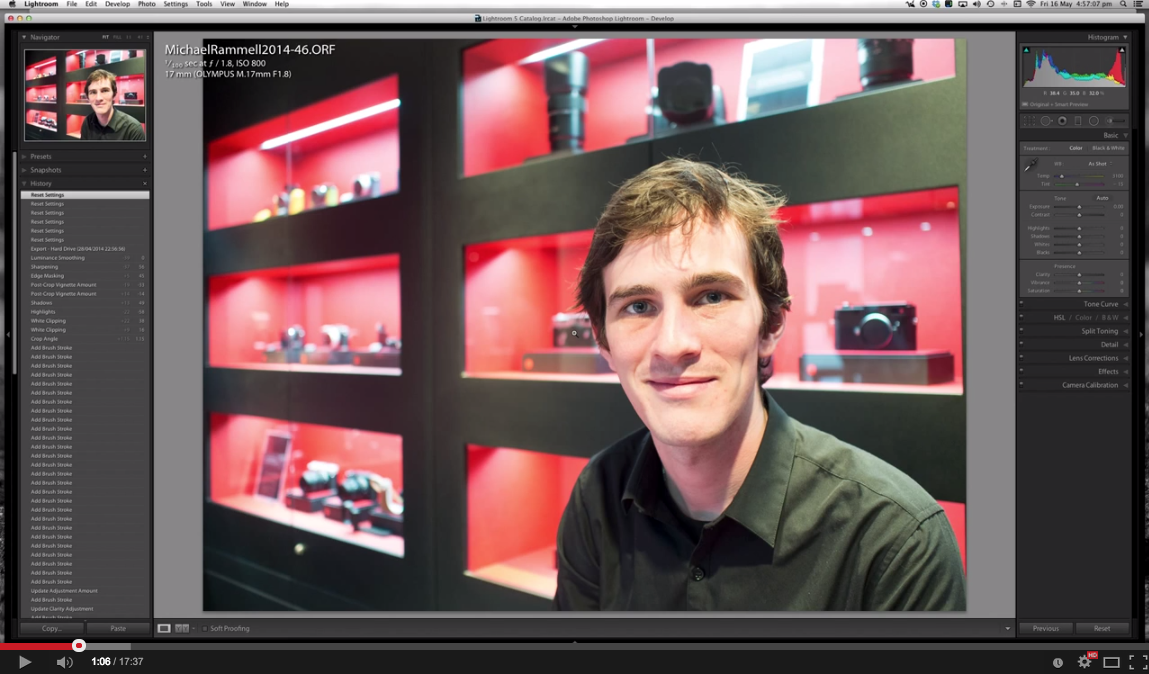

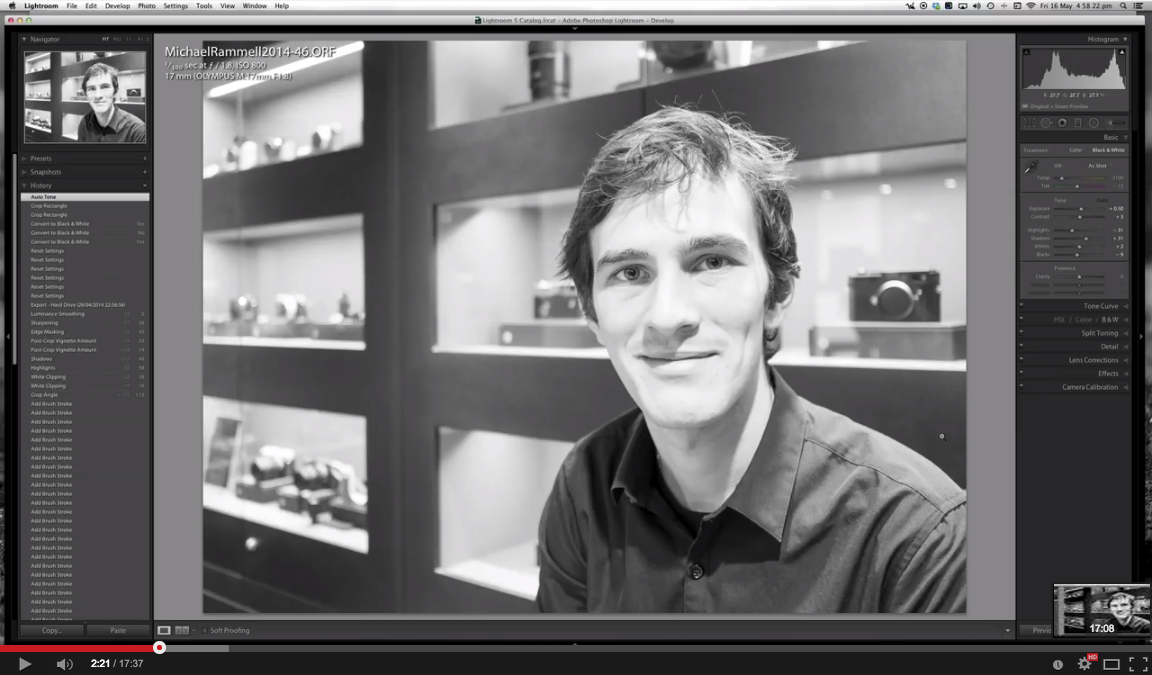
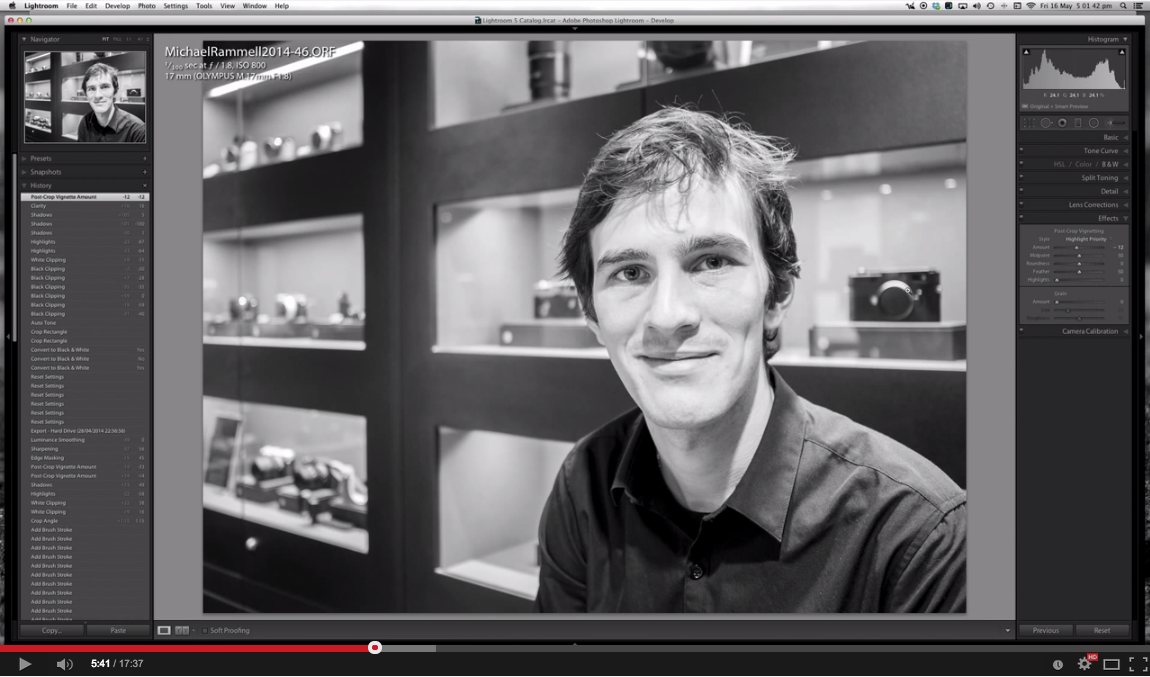
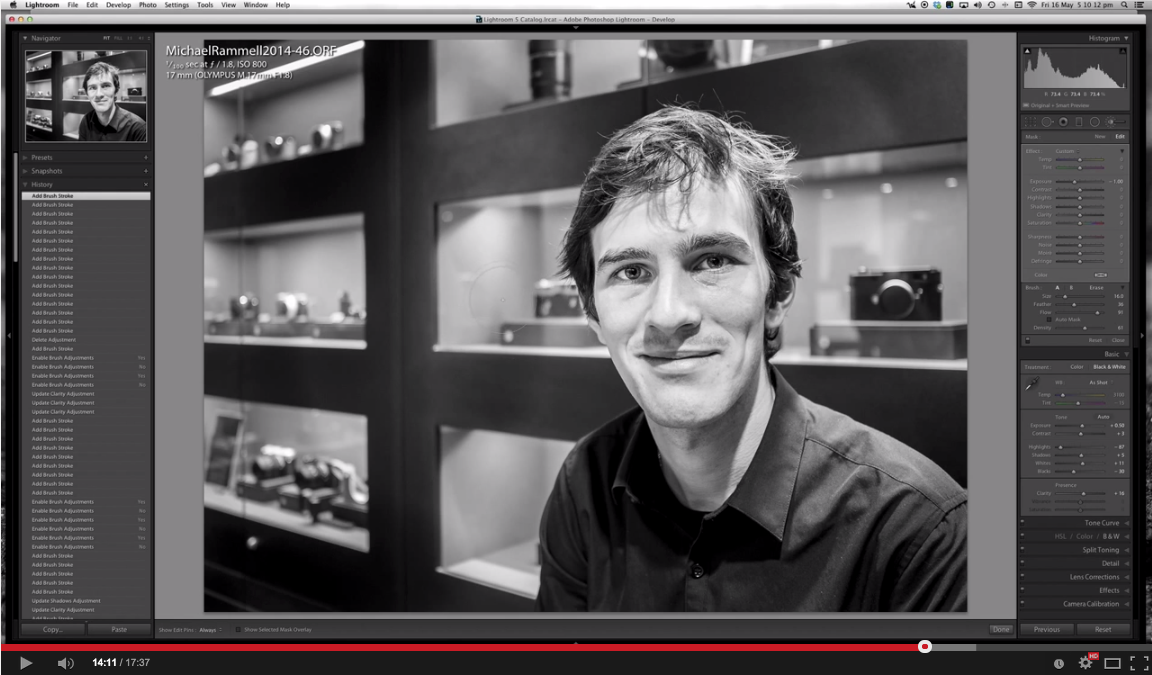
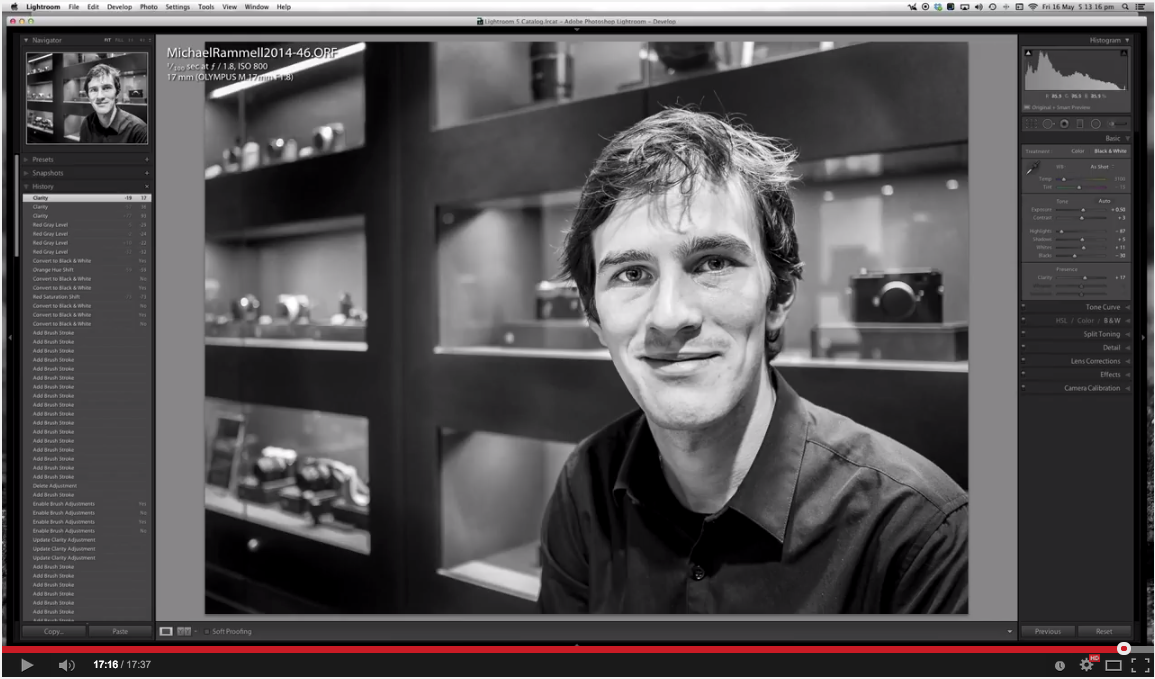
Silver Efex Pro 2
Sometimes, for when you want to just pull 'more' out of a black and white image: Silver Efex Pro 2 should be your go-to software. I find it most effective on subjects that don't include people, such as landscapes and architecture, but in truth, it has the uncanny ability to be able to produce a very pleasing black and white and often reveal textures and shadows you didn't think were present.
I'm not a fan of plugins, presets and actions etc, but Nik Silver Efex Pro 2 is my single exception to this belief because it is so effective. I haven't prepared a video, but I have spoke about Silver Efex Pro 2 before and it's superb qualities. Here, take a look at these side-by-sides, showing my best attempt at a mono conversion, aside a version of the same photograph that has been ran through Silver Efex:

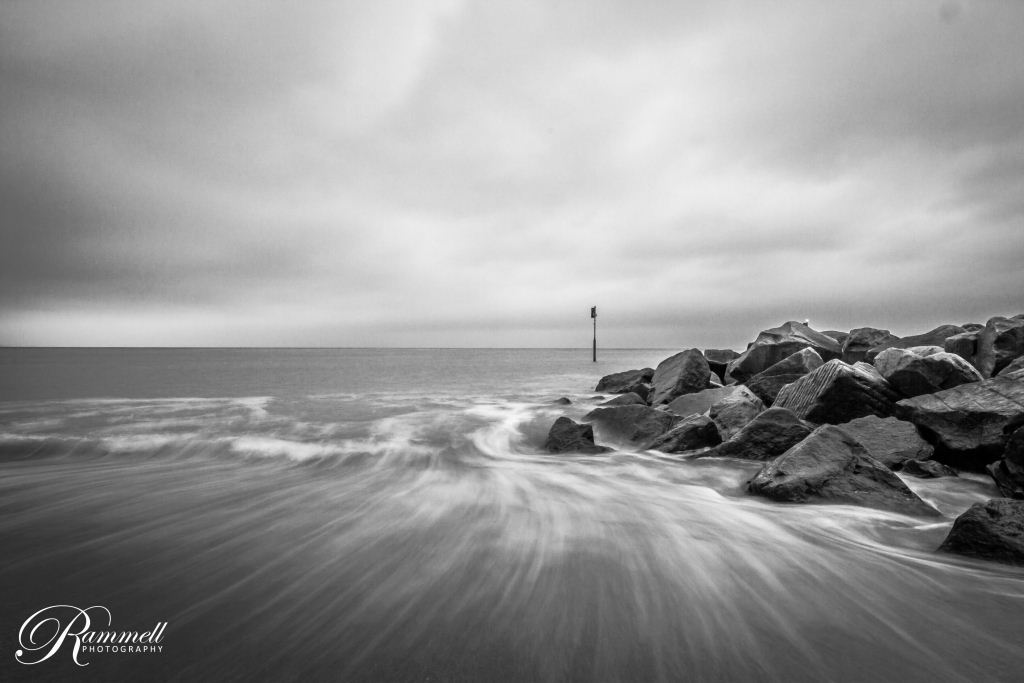
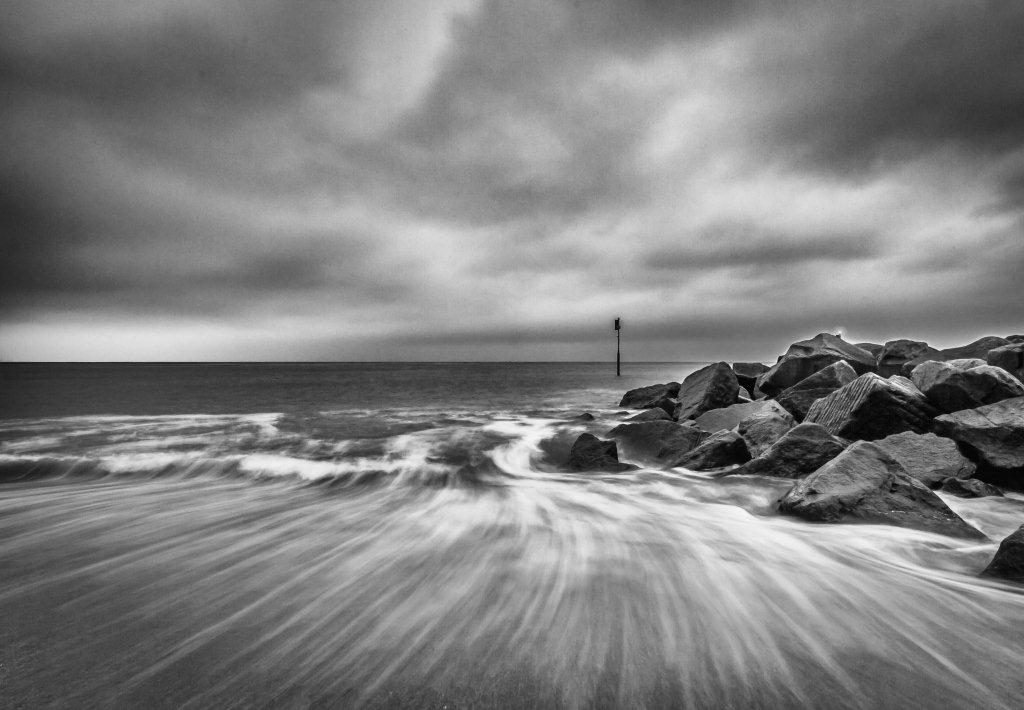


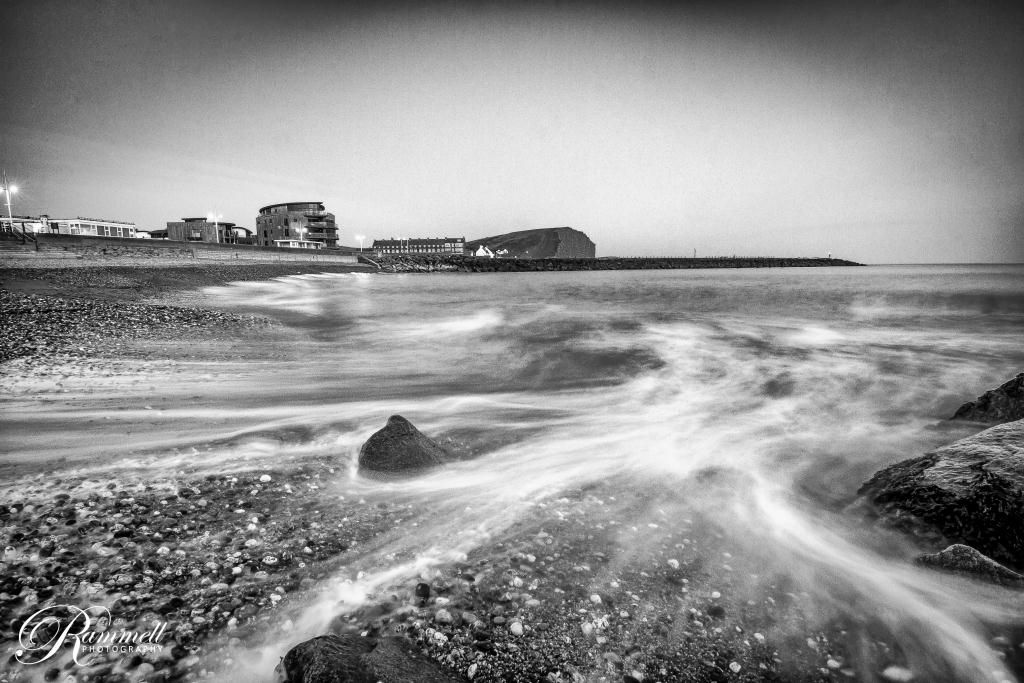
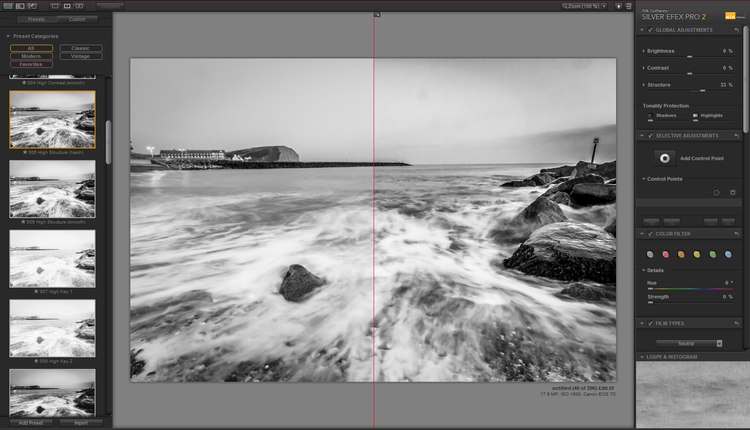
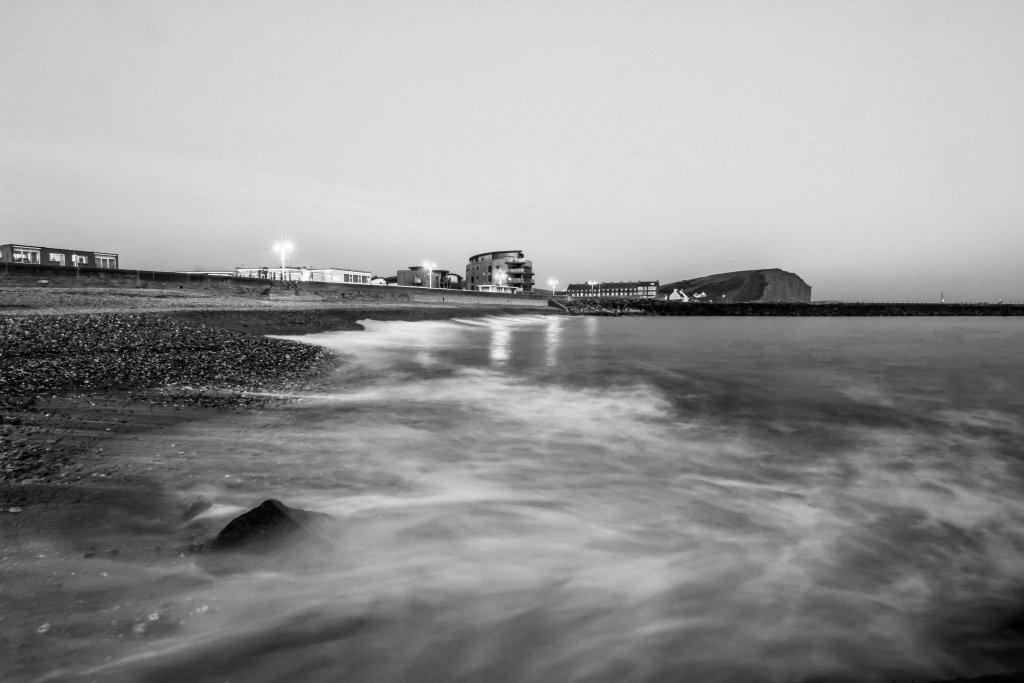
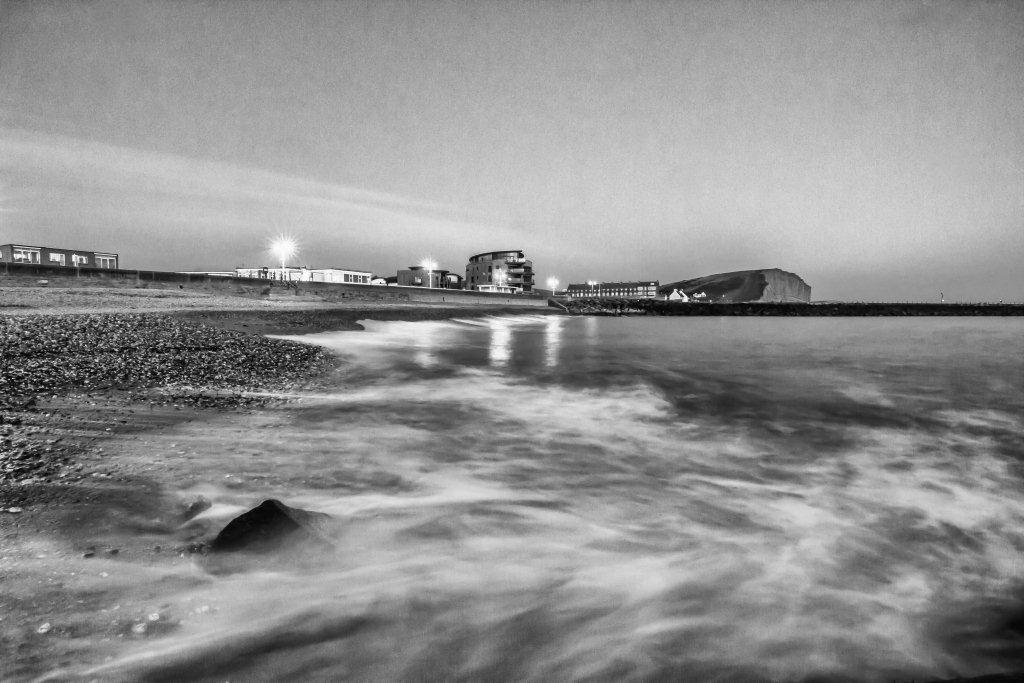
Inspiring Black and White Photographers
To finish this post I thought it only fair that I share with you some of the photographers I adore that are known for their monochrome photography, or, whose black and white work I simply adore. Take a look and let me know what you think.
Alternatively, are there any mostly-mono photographers you admire that you think the world ought to know about? Share them here in the comments and I'll add their names to this list:
Gregory Heisler
Mark Seliger
Fan Ho
Neil Buchan-Grant
Mary Ellen Mark




























